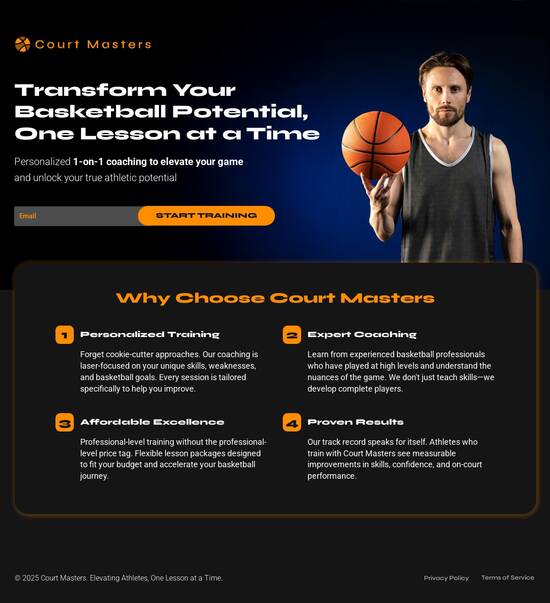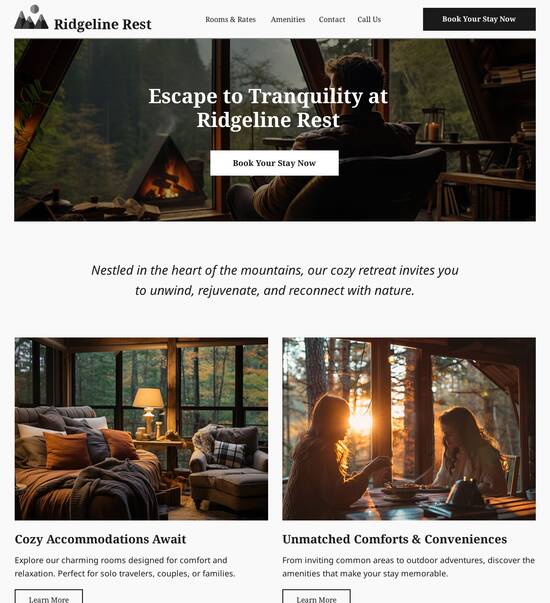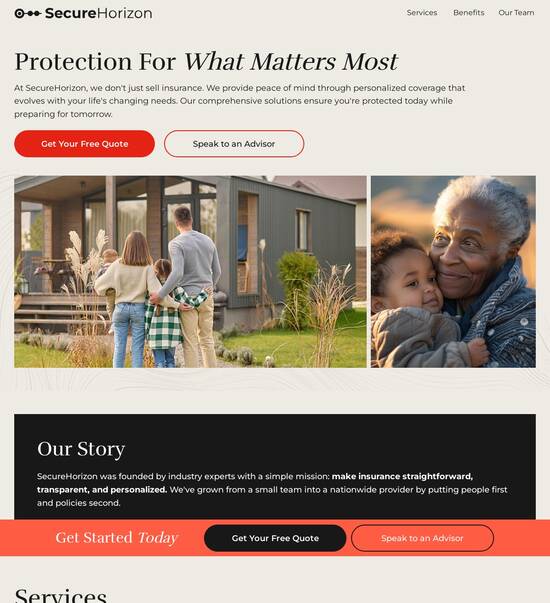
Webinar registration page template for UX/UI designers
Explore Similar TemplatesAbout template
Master your online marketing with this builder for webinar registration page template for UX/UI designers. Try more tools to create an immaculate landing page.
Recommended templates

Easy to build without coding
With the intuitive drag-and-drop builder, anyone on your team can create high-converting pages without any knowledge of code or design. Make enhancements to your landing page with custom widgets using Javascript, HTML/CSS, or third-party scripts.

Multiple layouts for any industry and goal
Select from 500+ landing page layouts built to boost conversions across industry-specific scenarios. Customize them by adjusting fonts, adding images, and generating on-brand content with the AI assistant. Quickly scale with Instablocks® and Global Blocks that you can save, reuse, and update globally.

Loads fast and looks polished on any device
Every template is responsive, which means they present professionally on any device and load blazingly fast with our Thor Render Engine. You can also power them up with Google AMP technology to deliver an unparalleled mobile experience and drive higher conversions.

Robust analytics & experimentation
Get real-time updates and reporting across all your devices, showing the number of visitors, conversions, cost-per-visitor, and cost-per-lead. Launch AI-powered experiments, run A/B tests, and use heatmaps to analyze user behavior, then optimize your landing page to maximize conversions.







Easy to build without coding
With the intuitive drag-and-drop builder, anyone on your team can create high-converting pages without any knowledge of code or design. Make enhancements to your landing page with custom widgets using Javascript, HTML/CSS, or third-party scripts.
Multiple layouts for any industry and goal
Select from 500+ landing page layouts built to boost conversions across industry-specific scenarios. Customize them by adjusting fonts, adding images, and generating on-brand content with the AI assistant. Quickly scale with Instablocks® and Global Blocks that you can save, reuse, and update globally.
Loads fast and looks polished on any device
Every template is responsive, which means they present professionally on any device and load blazingly fast with our Thor Render Engine.
Robust analytics & experimentation
Get real-time updates and reporting across all your devices, showing the number of visitors, conversions, cost-per-visitor, and cost-per-lead. Launch AI-powered experiments, run A/B tests, and use heatmaps to analyze user behavior, then optimize your landing page to maximize conversions.
All the features you need to build lead-generating landing pages
Explore more featuresLearn how to build top-performing landing pages for any goal
FAQs
Leading the way in building high-performing landing pages





Master your marketing with Instapage: A step-by-step guide for landing page optimization
Creating effective landing pages is crucial for enhancing your marketing campaigns. Instapage, a powerful platform specializing in landing page and conversion rate optimization (CRO), provides marketers the tools needed to increase ROI, generate leads, and enhance customer engagement throughout various industries such as tech, business services, and education.
Understanding the essentials of landing pages
Landing pages serve as standalone web pages designed to prompt users towards a specific action, whether it's signing up, purchasing, or requesting information. Utilizing high-converting templates and lead-gen elements like forms and CTA buttons is vital. Instapage offers over 100 customizable templates, ensuring a tailored approach to every campaign.
- Targeted design: Tailor your landing pages to resonate with your specific audience's needs.
- Simplified elements: Include clear CTAs and utilize eye-catching visuals to guide your visitors.
- Analytics integration: Use built-in dashboards to track and measure performance, making necessary adjustments.
Step 1: Crafting your landing page
Begin by choosing a template that aligns with your campaign's goals. Consider utilizing Instablocks for easily customizable sections that save time without sacrificing quality.
- Select a template: Choose from high-converting designs specific to your audience sector.
- Customize visuals: Add images and graphics that complement your brand identity.
- Implement tracking: Set up analytics to monitor user behavior and interactions with your page.
Step 2: Optimizing for conversions
Once your page is created, focus on elements that enhance conversion rates. Conduct A/B testing to determine what resonates best with your audience.
- Dynamic elements: Use personalized content that adjusts based on user demographics.
- Engagement features: Incorporate interactive elements like quizzes or chatbots to engage visitors actively.
- Optimize load times: Ensure your page loads quickly to reduce bounce rates.
Step 3: Analyze and iterate
With your page live, continuous analysis is key to maximizing performance. Regularly review heatmaps and analytics to understand user behavior and make data-informed decisions.
- Utilize heatmaps: Gain insight into how visitors interact with your page to find areas for improvement.
- Regular updates: Refine your content and visuals based on performance data.
- Seek feedback: Encourage users to provide input to further enhance the landing experience.
By following this guide, marketers can create high-performing landing pages that engage and convert audiences effectively.
Ready to elevate your digital marketing efforts? Start using Instapage today to unlock the potential of optimized landing pages tailored to your specific needs.
People also ask about Webinar registration page template for UX/UI designers
Webinar registration page template for UX/UI designers
Understanding the importance of webinar registration pages for UX/UI designers
Webinar registration pages play a pivotal role in determining the overall success of any online event. For UX/UI designers, understanding the nuances of these pages is critical in crafting experiences that enhance user engagement and drive registrations. When the registration page is user-friendly and visually appealing, it not only encourages users to sign up but also sets the tone for the upcoming webinar.
The role of a registration page in a webinar's success cannot be overlooked. An effective page serves as the first point of interaction between potential attendees and the brand offering the webinar. A well-designed registration page can dramatically increase conversion rates, turning casual interest into actual attendees. By integrating UX/UI principles, designers can streamline the registration process and improve user satisfaction.
Many successful webinars have shown that thoughtful design can directly impact registration figures. For instance, businesses that implement A/B testing methodologies on their registration pages often discover insights that lead to significant improvements in conversion. With each case study presenting unique designs, designers can learn and adopt best practices that resonate with their target audience.
Core elements of an effective webinar registration page
A well-crafted webinar registration page incorporates several core elements that work together to convert visitors. First and foremost is an impactful headline and subheadline. These components are vital in using persuasive language to draw users in. By crafting headlines that speak directly to the audience's needs, designers can grab attention right away.
Utilizing power words such as 'exclusive' or 'limited time' enhances urgency.
Emotional hooks resonate with potential attendees, making them more likely to sign up.
Next, enticing visuals and photography are essential. The role of relevant imagery in conveying value cannot be understated; images should reflect the subject matter of the webinar and appeal to the target audience. Designers can integrate flyers into their digital design strategy by using creative ideas that align visual elements with the overall message of the webinar.
Lastly, a compelling event description is crucial. Crafting a narrative that sparks interest involves highlighting key takeaways and benefits attendees will gain. A clear and concise description will ensure users are fully informed about what to expect, thereby increasing the likelihood of registration.
Structuring your registration form for maximum conversion
The next step in optimizing a webinar registration page involves structuring the registration form for maximum conversion rates. Essential fields must be designed with the user's ease in mind. At the very least, a registration form should include the name, email address, and password creation fields for user convenience. These essential fields are straightforward, reducing barriers for users willing to register.
Name field: A simple way to personalize the communication.
Email address: The primary means of notifying users about the event.
Password creation: Consider options to allow users to improve their experience.
Optional fields can be added to capture additional data, but it’s essential to find the right balance between acquiring useful information and ensuring a smooth user experience. Additionally, implementing a 'Remember Me' feature can significantly enhance the experience for returning users, making their next registration process seamless.
Incorporating UI/UX best practices
Applying UI/UX best practices can dramatically affect the usability of a registration page. Design principles, such as color theory, can play a pivotal role in guiding user attention to key areas of the page. By selecting colors that evoke specific emotions and prompt action, designers can foster a positive user experience.
Typography choices are equally important. Fonts must enhance readability and maintain visual appeal. It’s sensible to choose sizes and styles that cater to various devices, ensuring optimal experiences across the board. While assessing colors and fonts, one must not overlook navigation and layout strategies, particularly the importance of having a clear call-to-action button prominently displayed.
Using white space effectively to improve focus on registration elements.
Optimizing load times to reduce bounce rates.
Enhancing the user journey through personalization and engagement
The user journey can be significantly enhanced through personalization and engagement tactics. Utilizing cookies plays a crucial role in tailoring the browsing experience. By remembering past visitors, designers can create a more personalized interaction during subsequent visits by suggesting relevant webinars based on past interests.
Moreover, personalized follow-up sequences post-registration are paramount. Employing segmentation techniques can direct tailored communication to various user groups. This includes customizing reminder emails to ensure attendees retain the event's relevance and follow-up thank you emails that express appreciation for their participation.
Leveraging data analytics for continuous improvement
Data analytics is invaluable for continuous improvement of a webinar registration page. Tracking specific metrics helps measure success, including registration versus attendance rates, which not only informs marketers of their reach but also highlights areas for enhancement. User engagement metrics, including click-through rates and interaction levels, provide insight into how well the registration page is performing.
A/B testing is an effective strategy for experimenting with different registration page templates. By trying out various elements, such as headlines, color schemes, or imagery, designers can identify which components drive the most registrations, refining their approach based on real user data.
Exploring unique template features for webinar registration pages
The flexibility of webinar registration page templates is critical for catering to diverse needs. Agency and freelancers-focused templates can celebrate individual branding while providing structure for clear communication. Effective designs ensure that a personal touch isn't lost amid customization.
Dynamic content options allow customization for different target audiences, enhancing relevance.
Mobile optimization strategies ensure the registration page is responsive across devices.
As many users now access webinar registrations via mobile devices, optimizing for all platforms is no longer optional. Responsive design principles ensure accessibility, catering to varying user behaviors and needs.
Addressing common challenges in webinar registration design
Designing an effective webinar registration page comes with its challenges. Overcoming form abandonment is crucial, as users often leave the page before finalizing their registration. Implementing best practices such as minimizing the number of fields and ensuring that the form is visually appealing can help retain user interest.
Additionally, accessibility must be prioritized so that users of all abilities can engage with the registration process effectively. This may include ensuring the design complies with WCAG standards, offering keyboard navigability, and providing alternative text for images. Balancing informative content with visual appeal also remains an ongoing challenge for designers.
The impact of branding on webinar registration page success
Branding plays an essential role in a webinar registration page's success. Utilizing consistent colors, fonts, and logos builds trust and recognition among potential attendees. The integration of trust signals, such as testimonials and logos from well-known clients, can significantly enhance users' feelings of security and likelihood of registration.
Moreover, strategies for creating lasting impressions, such as incorporating engaging videos or interactive elements, can make the registration page memorable and entice users to sign up while fostering a stronger connection with the brand.
Marketing your webinar through the registration page
Once the registration page is optimized, driving traffic to it is the next step. Harnessing SEO strategies and employing targeted keywords can significantly increase visibility. By optimizing metadata and utilizing strategic keywords, designers can boost organic search rankings and attract more attendees.
Utilizing social media and online advertisements can broaden reach and engagement.
Designing eye-catching ads that pair effectively with your flyer enhances brand cohesion.
Collaborating with online magazines for wider outreach can expose the webinar to a whole new audience.
Taking these steps ensures not just increased registrations, but also enhances familiarization with the brand behind the webinar.
Final thoughts on optimizing your UX/UI design skills through webinar strategies
In conclusion, understanding and implementing effective strategies for webinar registration pages allow UX/UI designers to not only enhance their design skills but also improve the overall success of the web events they support. Regularly engaging in continuous learning and experimentation opens avenues for innovative self-improvement.
By turning insights from webinar registrations into practical applications on other projects, designers can ensure they keep evolving in their craft, creating experiences that captivate users and drive successful user engagement.
Ready to skyrocket conversions?
Supercharge your ad campaigns with high-performing landing pages
Get started














